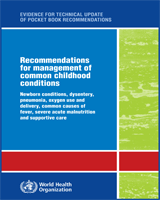All rights reserved. Publications of the World Health Organization are available on the WHO web site (www.who.int) or can be purchased from WHO Press, World Health Organization, 20 Avenue Appia, 1211 Geneva 27, Switzerland (tel.: +41 22 791 3264; fax: +41 22 791 4857; e-mail: tni.ohw@sredrokoob). Requests for permission to reproduce or translate WHO publications – whether for sale or for noncommercial distribution – should be addressed to WHO Press through the WHO web site (http://www.who.int/about/licensing/copyright_form/en/index.html).
NCBI Bookshelf. A service of the National Library of Medicine, National Institutes of Health.
Recommendations for Management of Common Childhood Conditions: Evidence for Technical Update of Pocket Book Recommendations: Newborn Conditions, Dysentery, Pneumonia, Oxygen Use and Delivery, Common Causes of Fever, Severe Acute Malnutrition and Supportive Care. Geneva: World Health Organization; 2012.

Recommendations for Management of Common Childhood Conditions: Evidence for Technical Update of Pocket Book Recommendations: Newborn Conditions, Dysentery, Pneumonia, Oxygen Use and Delivery, Common Causes of Fever, Severe Acute Malnutrition and Supportive Care.
Show details12.1. Choice of intravenous fluids for resuscitation and maintenance in children
- Resuscitation: Children severely dehydrated or with signs of shock should be resuscitated using isotonic intravenous (IV) solutions such as sodium chloride 0.9% or ringers lactate.(Strong recommendation, low quality evidence)
- Intravenous maintenance fluid: For children who require intravenous (IV) fluids for maintenance, options include ringers lactate solution with 5% dextrose, sodium chloride 0.45% with glucose 5%, sodium chloride 0.45% with glucose 2.5%, or 0.9% sodium chloride with glucose 5%.(Strong recommendation, low quality evidence)
- Low sodium-containing IV solutions such as sodium chloride 0.18% with glucose 4%, or 5% glucose in water, should not be used as there is an increased risk of hyponatraemia.(Strong recommendation, low quality evidence)
There is evidence that there is a greater level of risk of hyponatraemia associated with the use of very low sodium-containing solutions in paediatric patients in comparison to fluids where the sodium content is 75–150mmol/L.
The panel also emphasized that IV maintenance fluids should contain glucose to avoid hypoglycaemia and starvation ketosis. Enteral feeding should be used in sick children, as it provides nutrition and avoids complications associated with IV fluids. If oral nutrition is not tolerated, nasogastric tube feeding should be considered.
12.1.1. Evidence and summary of findings
There is evidence of a greater level of risk of hyponatraemia associated with the use of hypotonic solutions: the odds of developing hyponatraemia following hypotonic solutions are 17.2 times greater than with isotonic fluids. Within the range of hypotonic solutions available, the use of sodium chloride 0.18% with glucose 4% presents an even greater risk.
The panel identified a systematic review published in 2006 that sought to compare outcomes for children receiving hypotonic versus isotonic fluid therapy [Choong, 2006]. The review included six studies: two controlled trials of children (1-12 years, n = 60) and adolescent females (12–18 years, n = 12) undergoing elective procedures; one trial of children with gastroenteritis and dehydration (6 months–14 years, n = 104); one case-control study of children treated for iatrogenic hyponatraemia (mean age 7 years, n = 148); one cohort study of children undergoing scoliosis repair (6–16 years, n = 24); and one retrospective chart review of children undergoing craniofacial surgery (2 months–15 years, n = 56). Hypotonic solutions used in the studies ranged from 0.16–0.45% sodium chloride.
Only three studies reported on morbidity and mortality. Wilkinson et al [1992], reported seizures in 2 out of 26 patients receiving hypotonic fluids (OR 6.22; 95% CI 0.29 to 135.8). Hoorn et al [2004] reported nausea and vomiting more commonly in patients with hospital acquired hyponatraemia (p = 0.008) but numbers were too small to evaluate these outcomes with sufficient power.
Meta-analysis of the effect on serum sodium showed that hypotonic maintenance solutions significantly increased the risk of developing hyponatraemia (OR 17.22; 95% CI 8.67 to 34.2). Mean plasma sodium in patients following hypotonic solutions was significantly lower (OR -3.39 mmol/l; 95% CI -5.35 to -1.43), than those who received isotonic solutions. In children receiving hypotonic solutions, the mean plasma sodium decreased significantly more after fluid administration (OR -5.37 mmol/l; 95% CI -8.79 to -1.94). Three studies reported a decrease in plasma sodium despite the infusion of isotonic or near-isotonic maintenance fluids, but none reported on the risk of hypernatraemia with these fluids.
12.1.2. Benefits and risks
In two institutions in the UK where there were incidents of hyponatraemia due to use of hypotonic fluids, no further cases of iatrogenic hyponatraemia have been reported since the solution was removed from the ward stock. There is growing awareness of the dangers associated with use of hypotonic solutions and there have been various statements and changes in the national guidelines discouraging their use in children. In 2003, the Royal College of Anaesthetists issued a statement advising against the use of hypotonic fluids. In 2007, the UK National Patient Safety Agency (NPSA) issued an alert advice to health-care organizations of how to minimize the risks associated with administering intravenous infusions to children.
Risks
All sick children are potentially at risk of hyponatraemia, especially those with pulmonary and central nervous system infections, and post operative surgical cases. The use of hypotonic fluids may be harmful and cause water overload with possible severe hyponatraemia and other complications. Among children who develop symptomatic hyponatraemia, the incidence of permanent brain damage in adulthood is significantly increased [Chung 1986].
- Evidence for recommendations on the choice of intravenous fluids - Recommendatio...Evidence for recommendations on the choice of intravenous fluids - Recommendations for Management of Common Childhood Conditions
Your browsing activity is empty.
Activity recording is turned off.
See more...